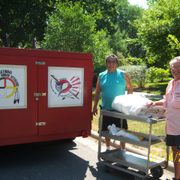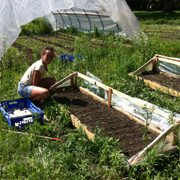-
A few years ago, Facilities Director Richard Strong taught a class at Carleton entitled Eco-House Design and Construction. A 17-foot Tipi constructed during the course has found a new home with the Winona-Dakota Unity Alliance.
-
Last Thursday marked the beginning of “Carleton Farm Volunteer Day”…
-
During spring term, Ellie Youngblood’14 and Tori Ostenso’15 worked on Carleton’s Farm to produce a great deal of vegetables. Thanks to them, 40lbs of Parsnips and 10lbs of micro-greens will be used in this Weekend’s Commencement Picnic.
-
Carleton Green Fund Initiative Passes by Resounding Margin
The Carleton administration and the Carleton Student Association (CSA) Senate usually follow the philosophy that Carleton students vote with their feet when it comes to environmental activism and education on the campus. Record turnout at environmental events, concerns about the environmental effects of Carleton’s food and appliance purchasing, and continued interest in the College’s Environment & Technology Studies program are all indicative that concern for the environment is becoming an entrenched Carleton value. However, last week students got the opportunity to actually vote for more environmental programming—and the results were astonishing.
When asked in a recent Senate election whether they would support the allocation of a portion of the Student Activity Fee to a “Green Fund,” an unprecedented 82.3% of those who voted said “yes.” This is one of the highest positive proportion of responses in the history of student referenda at Carleton. The Green Fund will be utilized by students and their organizations to fund environmentally-sustainable decisions and initiatives, and will be debuting on campus next fall, so get excited!
-
Bon Appétit’s Online Low Carbon Calculator
This summer, Carleton’s dinning halls will switch to a new dinning service, Bon Appétit. Bon Appétit advertises its “food services for a sustainable future”. While it will be up to Carls to see for themselves just how environmentally sustainable Bon Appetit’s food is, they sure do have a very cool website related to determining the environmental impact of meals. Simply drag each dish or food item into a digital frying pan and the site will calculate carbon dioxide equivalent points (grams of carbon dioxide equivalent greenhouse gases emitted to put that food on your plate). I used this handy tool to determine that I can cut my carbon emission in half by choosing a veggie omelet over a meat and cheese omelet. And, it is very specific. For example, when selecting fruit you can select whether fruits are seasonal or tropical and when selecting meats, you can specify the cut (deli slices, tenderloin, prime rib, etc). Through testing out various combinations of food, I learned that a grilled tenderloin beef dinner has one of the largest carbon footprints of all meals. The sight also includes meal specific tips on how to go on low carbon diet (such as, “lose the cheese on that burger”)
To begin exploring the carbon impact of your own diet, check out:
http://www.eatlowcarbon.org -
As part of its strong commitment to sustainability, Carleton is in the midst of finalizing building plans for two new LEED Gold certified dormitories. The LEED Gold dormitory project will be one of the first in Minnesota and will add more than 200 new beds on campus. LHB, a firm based in the twin-cities, and members of the Carleton community are currently finishing the schematic designs and hoping to select a contractor soon. If all goes well, the dorms will be up and running by fall of 2009.
-
The Mighty Turbine – January 2008 Data

While the students and faculty at Carleton suffered from cold temperatures and blustery wind chills during the month of January, Carleton’s wind turbine had a heyday. Throughout the month, the turbine generated 419,506 kilowatt-hours of electricity, generating the college $20,136.29 in income (since all energy produced is sold to Xcel Energy). However, if the energy generated from the turbine flowed directly to Carleton, it would have provided the campus with 36.4% of its needed electricity (based on 2006 use). Also, by providing renewable energy to the community’s power grid, the turbine averted almost 258.44 metric tonnes of carbon dioxide emissions.
-
Rachel English is a philosophy major in the class of 2008. This article was originally published in the Viewpoints section of the Carletonian.
On October 24th, the Sustainable Endowment Institute (SEI) published its second annual “College Sustainability Report Card.” To almost everyone’s surprise, as we on the campus noted no huge leap in campus sustainability during the same time frame, Carleton managed to bound from a C+ to an A- between this year’s report and last. The change was mainly due to our catapult from C’s and F’s to A’s and B’s in the Endowment categories, prompting Carleton’s recognition as one of three “Endowment Sustainability Leader,” and contributing to our recognition as one of six “Overall Sustainability Leaders.”
The main boost came, not from anything outstanding Carleton did, but from SEI’s ineffective evaluation procedures. Carleton had, and has had for the last three years, the Carleton Responsible Investing Committee (CRIC). But SEI could not find it–it noted in its first report that Carleton “has not made any public statements” about its investment practices, causing Carleton to earn an F in two of the three investment categories. This is a problem because, in addition to a survey, SEI’s only method of evaluation is–according to the methods section of their report–through “publicly available documentation. Sources included the institution’s website and media coverage,” as well as more reliable places like the Association for the Advancement of Sustainability in Higher Education (AASHE).
Of course, no one really can be blamed for failing to find information on Carleton’s unsearchable website, but you might think that the “Administrative and Governance Committees” webpage which does list the CRIC would be one obvious place to begin a search. (To be fair, although the CRIC does have a webpage, no link is provided from the committees webpage, although I was assured one would be coming soon).
The real difference between this year’s results and last’s seems to be that Carleton actually took the survey seriously this year. As a senior college administrator pointed out, this was somewhat hard to do, since SEI seems like somewhat of a joke–last year it sent each part of the survey to a separate person, in the process mistaking the Burton dining hall manager for Carleton’s actual dining manager.Continue by clicking the “read more” link below
-
Our friends over at Williams had their take on this, and I wanted to add a few more points about the differences between Renewable Energy Certificates (RECs) and Offsets.
First of all, RECs and offsets are entirely different environmental commodities. There are many misconceptions about RECs and offsets, and while some will say that it is because vendors have been misleading, I think it is more likely due to the fact that they are both somewhat abstract concepts to consumers and it does require a fair amount of research to be able to understand the differences between them.
A REC, also referred to as a green tag, represensts the environmental benefits of one megawatt-hour of electricity generated by a renewable sources such as wind, solar, or small-scale hydropower. Another commonly cited benefit of RECs is that the money will incentivize the production of renewable energy resource.
As many of our readers probably know, with out turbine, Carleton’s renewable energy credits were sold to Xcel and served as a monetary incentive to construct our wind turbine. Though I was not at Carleton when talks about the turbine were taking place, it is easy to say that the project might not have been financed if Carleton hadn’t been able to sell the credits.
Continue by clicking the “read more” link below
-
People rarely think of rainwater as an environmental problem unless it is somehow related to climate change and new precipitation patterns. However, stormwater runoff is responsible for heavily polluted water bodies, flooding, and thermal pollution of sensitive waters. These consequences can have larger impacts on the integrity of natural resources and their ability to provide habitat for wildlife. Consequently, U.S. law requires that non-point source water pollution be regulated through the National Pollution Discharge Elimination System (NPDES) program. Maintaining the integrity of the watershed is Carleton’s responsibility given the water quality regulations that exist.
At Carleton, stormwater pipes conduct water from buildings, parking lots, and concrete sidewalks into a small group of water bodies, including the Cannon River, Spring Creek, Lyman Lakes, and a couple stormwater retention ponds located on or near campus. As Carleton moves forward with its campus expansion plans (the Arts Center and the new dormitory) storm water management becomes increasingly important. How will the college handle increased runoff associated with new impermeable surfaces? How will we maintain the integrity of water in our local watershed? Fortunately, there are ways to deal with stormwater runoff. Green roofs and permeable pavement are two green designs that increase natural drainage and filtration, reducing the impact of large inputs of stormwater.
Continue by clicking the “read more” link below




